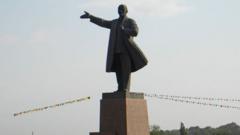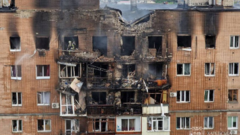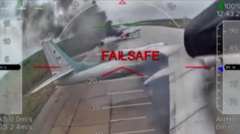This article explores the shifting dynamics in Crimea, once a thriving hub for millions of visitors, now reeling under isolation and continuous military threats.
**Crimea's Isolation: A Tourist Destination in Turmoil Amid Ongoing Conflict**

**Crimea's Isolation: A Tourist Destination in Turmoil Amid Ongoing Conflict**
As Ukraine intensifies drone strikes against Crimea, the region feels the dual impact of military tensions and a dwindling tourist influx.
In a region historically regarded as a crossroads of cultures, Crimea finds itself increasingly inhospitable due to the ongoing Ukraine conflict. With every month, Ukraine launches multiple attacks on critical infrastructures like the Crimea bridge, utilizing methods such as underwater explosives to exacerbate disruption. These strikes have turned the bridge—the main connection between mainland Russia and the Black Sea peninsula—into a perilous route, with closures lasting several hours as residents and tourists alike are warned of safety hazards from air defenses targeting incoming drones.
Since Russia's annexation of Crimea in 2014, the peninsula has not only become a hotbed for military tensions but has also heavily influenced local life and tourism. Previously welcoming around six million visitors from Ukraine and Russia annually, these numbers have plummeted since the incursion, further exacerbated by last year's full-scale war. Today, Crimea largely attracts Russian tourists, who flock to its beaches while navigating the shadows cast by the threat of Ukrainian drone strikes and military engagements.
Russian officials, claiming historical justification for their takeover, have resisted abandoning their grip on the peninsula, asserting demands for recognition of their sovereignty in peace negotiations. Ukrainian President Zelensky has continually asserted their claim to the territory, rejecting any notion of giving up. Meanwhile, former U.S. President Trump's recent comments suggest that any peace agreement may involve the U.S. acknowledging Russian control over Crimea, a move that raises eyebrows among many observers.
The implications for daily life in Crimea have been profound, morphing the area from a vibrant tourist destination into a largely isolated landscape marked by risks and a patriotic culture that downplays the ongoing conflict. The phrase “Crimea is Ours,” a slogan echoing the Kremlin's narrative post-annexation, reflects a growing sentiment that perceives the conflict more as a nuisance than a pressing concern. As Crimea grapples with its identity in this fraught geopolitical atmosphere, the future remains uncertain, highlighting the complex interplay between national sovereignty, regional conflict, and civilian life.
Since Russia's annexation of Crimea in 2014, the peninsula has not only become a hotbed for military tensions but has also heavily influenced local life and tourism. Previously welcoming around six million visitors from Ukraine and Russia annually, these numbers have plummeted since the incursion, further exacerbated by last year's full-scale war. Today, Crimea largely attracts Russian tourists, who flock to its beaches while navigating the shadows cast by the threat of Ukrainian drone strikes and military engagements.
Russian officials, claiming historical justification for their takeover, have resisted abandoning their grip on the peninsula, asserting demands for recognition of their sovereignty in peace negotiations. Ukrainian President Zelensky has continually asserted their claim to the territory, rejecting any notion of giving up. Meanwhile, former U.S. President Trump's recent comments suggest that any peace agreement may involve the U.S. acknowledging Russian control over Crimea, a move that raises eyebrows among many observers.
The implications for daily life in Crimea have been profound, morphing the area from a vibrant tourist destination into a largely isolated landscape marked by risks and a patriotic culture that downplays the ongoing conflict. The phrase “Crimea is Ours,” a slogan echoing the Kremlin's narrative post-annexation, reflects a growing sentiment that perceives the conflict more as a nuisance than a pressing concern. As Crimea grapples with its identity in this fraught geopolitical atmosphere, the future remains uncertain, highlighting the complex interplay between national sovereignty, regional conflict, and civilian life.






















